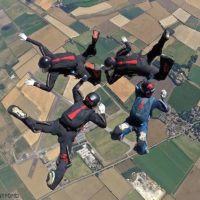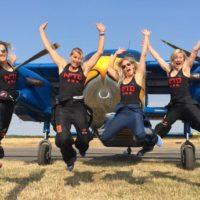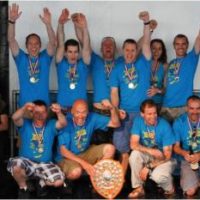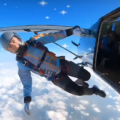- Swallow Group Dropzones:
- Skydive Hibaldstow
- Skydive Spain
- Skydive Algarve
Planning Your Team – Part One
Wednesday, September 25, 2019
The UK Nationals are over, you’ve either just taken part or you’ve never done it before. Either way, you’re on the hunt for a new 4-way skydiving team and this blog post is perfect for you. How do you find your teammates, work out a training plan and make sure you meet your team goals? This is the first in a two-part blog series which starts with “Finding the Right Team” and is written by Simon Brentford from team NFTO.
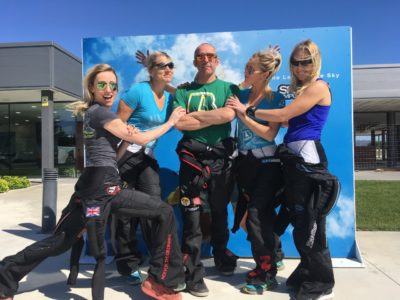 FINDING The Right Teammates
FINDING The Right Teammates
This is where it all starts. Let’s take a look at some of the common criteria you might be looking for when selecting your new teammates:
- Previous History. Many new teams start with a core of previous friends / teammates. This is always a good place to start as you know where you stand with them and you most probably get on with them already!
- Personality. Finding a good teammate is more than just a colleague. For the vast majority of us, this is our hobby and our passion. Getting on with your teammates is super-important, it helps you gel, gain skills more quickly and most likely, put in a good performance under pressure during competition. And let’s face it, it’s too much money to be spent if you are not having fun.
Look for someone who has that right combination of drive, commitment and team ethic. You don’t have to be a stoical selfless angel, but you do have to be able to recognise the good of the team to be able to fit in.Finding 5 like-minded skydivers isn’t always the most important part of team building. Often it’s the differences which come together to make the most successful. The team needs many different attributes such as strength, exit technique, speed of turning, accuracy, timing and seeing the team rhythm. - Team Activities. In addition, you need teammates who are great at admin, being leaders, managing social media, coaching, sourcing sponsors, keeping the peace, strategising and more. Often one teammate will be the most skilled. They can offer their skills on player-coach or the in-coach for when their external-coach is not available. There’s often a teammate who is perfect for organising the finances or the calendar.
- Commitment. There is no point having a super-experienced teammate if they are not able to commit to the training plan in terms of time or money. Likewise, you need teammates who won’t get frustrated when you all can’t give that extra 50 skydives or 2 hours of tunnel time.
- Weight. This is always a fractious subject, however, it needs to be discussed. It’s very rare to find a team where no one is wearing a weight belt. There will always be one or two teammates who are heavier than the rest. The lighter teammates, will end up wearing a weight belt to compensate for fall-rate. Having an even fall-rate allows individuals to adopt a neutral body position giving them the range to increase and decrease speed to adapt to specific randoms and blocks.
If you are the sort of team that means business and are targetting medals, then maybe you need to be accountable to each other with fitness and weight targets.
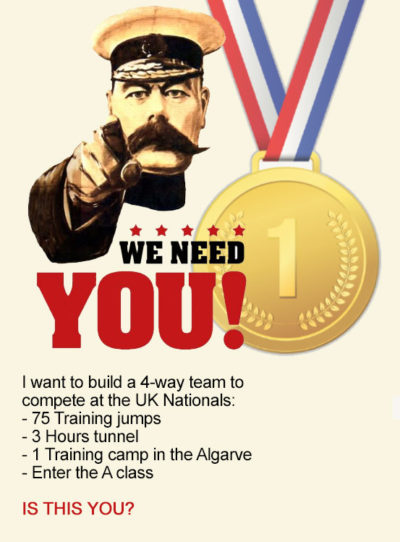 Advertising
Advertising
What do you do if there is no team to join or viable candidates at your local parachute center? Then, you have to look further afield. It might be worth putting a post on your Facebook profile saying you are on the hunt.
You can ask the friends you’ve made at other dz’s if they know of anything or search for “Meet and Greet” type events. Often it’s the local dz load organiser who is in the know and runs them. In fact, at Skydive Hibaldstow, we are running a Meet and Greet event where the dropzone hopes to put lots of likeminded talented skydivers together. It’s running 9th & 10th November 2019, you’re all welcome!
Being willing to travel will definitely widen your options!
You don’t need to be a confident socialite at the centre of every party with all the connections to find the right skydiving team, but writing straight-forward down to earth emails will definitely help.
Training Plan
Working out how often you are going to train, with whom and how much to spend is often the most challenging part of team building. It’s often a case of the lowest common denominator, who has the least ability to commit their time and money.
When you’re working out if you can commit, you have to be totally and brutally honest. There has been many a team who have broken up with just a few weeks to go before nationals because one teammate ran out of money or annual leave.
Creating a team plan should include the following:
- Total number of skydives you want to do and when.
- Tunnel time and when to do it.
- Selection of the right coach if he or she is not already a player-coach. His or her cost per day and also what happens when the weather is bad.
- Use of single or double skydiving rigs.
- Choice of packing for yourself or using packers.
- Inclusion within the plan of all the extra ancillary costs such as accommodation, BPA membership, nationals registration, petrol, evening meals, reserve pack jobs, etc – the list goes on.
- Which competitions you want to enter – a local dz 4-way comp, the UKSL series, UK Nationals, European Skydiving League finals, etc.
- When setting the team goals, e.g. a 10 average, winning a silver at the UK Nationals, etc – examine it based on previous experience. It’s important to find the right balance between being realistic, attainable and not pie in the sky.
- Picking which category you want to enter (Rookie, A, AA or AAA) might on the face of it seem like a simple decision, but not always. For example, if you think you are a second season AA class team, but only have a budget of 30 training jumps and a new Rookie class teammate; then actually, perhaps A class is a better choice. One thing you don’t want to be accused of is entering a class which is too low and then being thought of as a cheat.
Trials
It’s well worth doing some trials at your nearest wind tunnel before committing to a full year of training. It’s a great way of working out if you have compatible fall rates, want the same thing and come from a similar background. Make sure you find a coach to hire for that session (a max of half an hour should be enough). They can offer an honest and external point of view of who should take which slot and if you are compatible. The trials are also a great place to get a feel of each other’s commitment, personality and passion.
Try to structure the trials so that you get to see everything a potential teammate / team are capable of. Here’s a few examples of how to structure it:
- An all-random jump – e.g. A-E-M-Q.
- A jump where you have to show how good your 360’s are – e.g. 15-7.
- A 2-way jump where you practice side-slides and 180’s.
If there’s multiple jumpers involved in the trials, you will need to wear your diplomatic hat at the end of the process. Saying someone is rubbish and therefore hasn’t made the cut isn’t going to help you long-term. The world of skydiving is small enough that often if you decide against a potential teammate during one season, you may find that you end up working with them during another season. So don’t burn your bridges!
Having a Good think
If someone asked you to spend £3000 on a snazzy HIFI or TV, you’d want to test it out and have a good think if this is really what you want. Joining a skydiving team or picking a new teammate is no different. Really consider if you can work with these people, do you stand a good chance of achieving your personal goals and is it going to be a pleasurable experience?
Well, that’s it for part one of this article. Tune in next week for part two.
We are so social...
Follow Us!
Stay connected with us! Sign up to receive news and valuable promotions from Skydive Hibaldstow! We won’t spam you (we promise).
Copyright © 2024, Skydive Hibaldstow, All Rights Reserved.
DropZone Web Design & Marketing by Beyond Marketing, LLC
